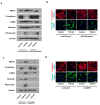miR-29b Regulates TGF-β1-Induced Epithelial-Mesenchymal Transition by Inhibiting Heat Shock Protein 47 Expression in Airway Epithelial Cells
- PMID: 34768968
- PMCID: PMC8584188
- DOI: 10.3390/ijms222111535
miR-29b Regulates TGF-β1-Induced Epithelial-Mesenchymal Transition by Inhibiting Heat Shock Protein 47 Expression in Airway Epithelial Cells
Abstract
Tissue remodeling contributes to ongoing inflammation and refractoriness of chronic rhinosinusitis (CRS). During this process, epithelial-mesenchymal transition (EMT) plays an important role in dysregulated remodeling and both microRNA (miR)-29b and heat shock protein 47 (HSP47) may be engaged in the pathophysiology of CRS. This study aimed to determine the role of miR-29b and HSP47 in modulating transforming growth factor (TGF)-β1-induced EMT and migration in airway epithelial cells. Expression levels of miR-29b, HSP47, E-cadherin, α-smooth muscle actin (α-SMA), vimentin and fibronectin were assessed through real-time PCR, Western blotting, and immunofluorescence staining. Small interfering RNA (siRNA) targeted against miR-29b and HSP47 were transfected to regulate the expression of EMT-related markers. Cell migration was evaluated with wound scratch and transwell migration assay. miR-29b mimic significantly inhibited the expression of HSP47 and TGF-β1-induced EMT-related markers in A549 cells. However, the miR-29b inhibitor more greatly induced the expression of them. HSP47 knockout suppressed TGF-β1-induced EMT marker levels. Functional studies indicated that TGF-β1-induced EMT was regulated by miR-29b and HSP47 in A549 cells. These findings were further verified in primary nasal epithelial cells. miR-29b modulated TGF-β1-induced EMT-related markers and migration via HSP47 expression modulation in A549 and primary nasal epithelial cells. These results suggested the importance of miR-29b and HSP47 in pathologic tissue remodeling progression in CRS.
Keywords: epithelial–mesenchymal transition; heat shock protein 47; microRNA; primary nasal epithelial cells; tissue remodeling; transforming growth factor beta-1.
Conflict of interest statement
The authors declare no conflict of interest.
Figures







Similar articles
-
TGF-β1 Induces Epithelial-Mesenchymal Transition of Chronic Sinusitis with Nasal Polyps through MicroRNA-21.Int Arch Allergy Immunol. 2019;179(4):304-319. doi: 10.1159/000497829. Epub 2019 Apr 12. Int Arch Allergy Immunol. 2019. PMID: 30982052
-
TGF-β1-induced HSP47 regulates extracellular matrix accumulation via Smad2/3 signaling pathways in nasal fibroblasts.Sci Rep. 2019 Oct 29;9(1):15563. doi: 10.1038/s41598-019-52064-1. Sci Rep. 2019. PMID: 31664133 Free PMC article.
-
Trichostatin A Inhibits Epithelial Mesenchymal Transition Induced by TGF-β1 in Airway Epithelium.PLoS One. 2016 Aug 29;11(8):e0162058. doi: 10.1371/journal.pone.0162058. eCollection 2016. PLoS One. 2016. PMID: 27571418 Free PMC article.
-
Epithelial cell dysfunction in chronic rhinosinusitis: the epithelial-mesenchymal transition.Expert Rev Clin Immunol. 2023 Jul-Dec;19(8):959-968. doi: 10.1080/1744666X.2023.2232113. Epub 2023 Jul 4. Expert Rev Clin Immunol. 2023. PMID: 37386882 Review.
-
The Role of Epithelial-Mesenchymal Transition in Chronic Rhinosinusitis.Int Arch Allergy Immunol. 2022;183(10):1029-1039. doi: 10.1159/000524950. Epub 2022 Jun 23. Int Arch Allergy Immunol. 2022. PMID: 35738243 Review.
Cited by
-
Epithelial-Mesenchymal Transition in Chronic Rhinosinusitis.J Rhinol. 2024 Jul;31(2):67-77. doi: 10.18787/jr.2024.00022. Epub 2024 Jul 31. J Rhinol. 2024. PMID: 39664411 Free PMC article. Review.
-
Insights into the epigenetics of chronic rhinosinusitis with and without nasal polyps: a systematic review.Front Allergy. 2023 May 22;4:1165271. doi: 10.3389/falgy.2023.1165271. eCollection 2023. Front Allergy. 2023. PMID: 37284022 Free PMC article. Review.
-
Role and Therapeutic Potential of miR-301b-3p in Regulating the PI3K-AKT Pathway via PIK3CB in Eosinophilic Chronic Rhinosinusitis.J Inflamm Res. 2025 Jul 30;18:10235-10251. doi: 10.2147/JIR.S521536. eCollection 2025. J Inflamm Res. 2025. PMID: 40756418 Free PMC article.
-
Epigenetic Mechanisms in CRSwNP: The Role of MicroRNAs as Potential Biomarkers and Therapeutic Targets.Curr Issues Mol Biol. 2025 Feb 10;47(2):114. doi: 10.3390/cimb47020114. Curr Issues Mol Biol. 2025. PMID: 39996835 Free PMC article. Review.
-
New insights into microRNA in dermatological diseases.Front Med (Lausanne). 2025 Aug 11;12:1624085. doi: 10.3389/fmed.2025.1624085. eCollection 2025. Front Med (Lausanne). 2025. PMID: 40861221 Free PMC article. Review.
References
-
- Fokkens W.J., Lund V.J., Mullol J., Bachert C., Alobid I., Baroody F., Cohen N., Cervin A., Douglas R., Gevaert P., et al. European Position Paper on Rhinosinusitis and Nasal Polyps 2012. Rhinol. Suppl. 2012;23:1–298. - PubMed
MeSH terms
Substances
Grants and funding
LinkOut - more resources
Full Text Sources
Miscellaneous

